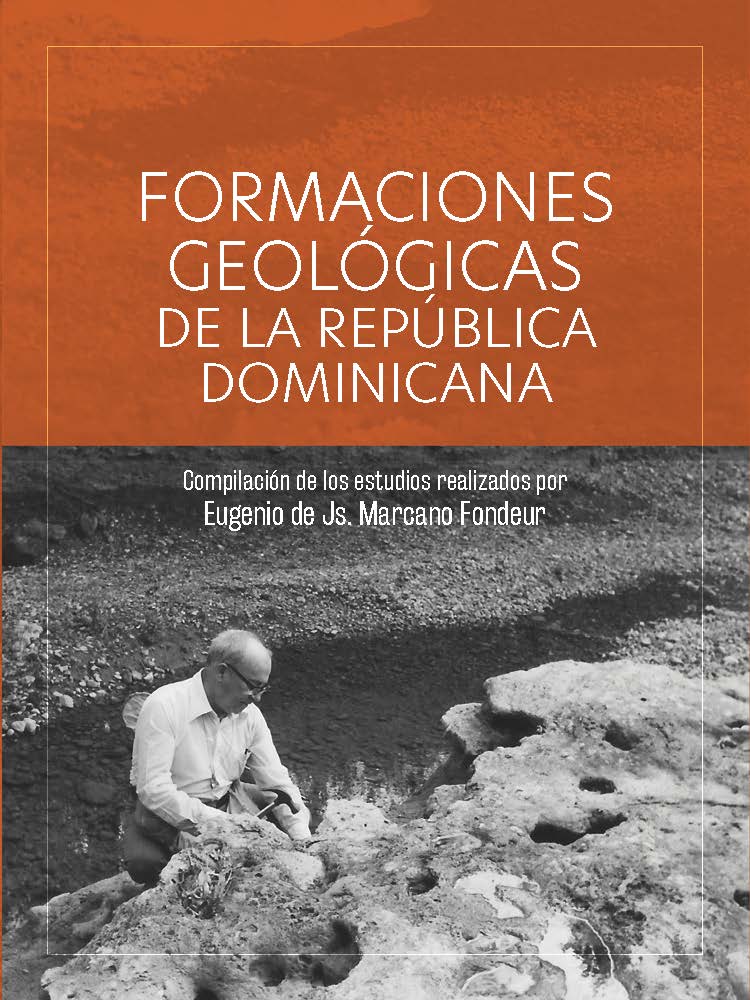Geological Formations of the Dominican Republic (En español)
The following studies were published in the book “Geological Formations of the Dominican Republic – Compilation of studies by Eugenio de Js. Marcano Fondeur”. A production of the National Museum of Natural History to celebrate the centenary of Prof. Marcano’s birth.
The book was released on September 26, 2023 and can be purchased at the Museum store in the Plaza de la Cultura.
Below are the summaries of each chapter.
- The Bulla Conglomerate
- Cercado Formation
- Isabela Formation. Early Pleistoceno
- Fossil Mollusks of Arroyo Blanco Formation
- Stratigraphic Position of the Cevicos Limestone Formation
- The Gurabo Formation of the Middle Miocene in the Dominican Republic
The Bulla Conglomerate
Eugenio de Js. Marcano F.
1981
Abstract
The presence of the Bulla Conglomerate is reported for the first time in several unreported locations, both north and south of the Central Cordillera. It is recommended to use the previous name for the conglomerate in the southern locations, as already done in the north. The locality 8529 (C-35) of Cooke, Vaughan and collaborators (1922) is actually a cliff called Barranca Colorada, 1 km downstream from the Bulla Conglomerate’s type locality. The Bulla Conglomerate should be maintained as an independent formation from the Lower Miocene due to its lithological characteristics and extent.
Cercado Formation
Eugenio de Js. Marcano F.
1981
Abstract
I. The eight recognized Miocene formations forming the western section of the Cibao Valley are re-studied and reduced to three:
- Early Miocene: Bulla Conglomerate Formation with the Baitoa Formation as the upper member
- Lower Miocene: Cercado Formation. Materials from the Caimito Formation are assimilated into it.
- Middle Miocene: Gurabo Formation, with Mao Adentro Limestone, Mao Clay, and Mao Formation as final members.
II. The boundaries of the Cercado Formation are fixed from the Mamey Section in La Vega municipality to La Vigía in Dajabón.
III. The Cercado Formation is found in the Las Cabras and Bellaco streams along with the only discovered fossil coral reef within the formation.
IV. The boundaries of the Bulla Conglomerate Formation extend from Caña Segura in the Carrera de Yegua Section of Las Matas de Farfán municipality to Niza in the San Cristóbal municipality.
Isabela Formation. Early Pleistocene
Eugenio de Js. Marcano F. y Iván Tavares C.
1982
Abstract
A new formation corresponding to the Early Pleistocene is described, named La Isabela Formation. It consists of reef limestone that, on the northern coastal plain between La Isabela and Luperón, rests unconformably on the Gurabo Formation of the Middle Miocene.
The type section is one of the “cuts” of the road that connects the former town of La Isabela with the Bajabonico River, about two kilometers south of the plaque commemorating the installation of the first city founded by Christopher Columbus in America.
The terrain is limestone-marl, cream-colored and powdery, with a large number of mollusk, echinoderm, crustacean, and reef coral fossils.
At the northern limit of the La Isabela Formation, the material that forms it is a hardened coastal reef limestone, yellowish-white, forming the Las Paredes cliff, which separates this formation from the more recent limestones of the coastal plain.
This work also reports, for the first time in the country, the presence of the Gurabo Formation north of the Northern Mountain Range.
Fossil Mollusks of Arroyo Blanco Formation
Téc. Biól. P. Consuelo Martínez T. y Eugenio de Js. Marcano F.
1994
Abstract
The list of fossil mollusks from the Lower Miocene Arroyo Blanco Formation in the Dominican Republic is presented, consisting of 174 species of Gastropoda and 66 of Bivalvia.
This fauna is poorly known and helps correlate faunas from other regions and better determine the age of the Arroyo Blanco Formation.
Stratigraphic Position of the Cevicos Limestone Formation
Eugenio de Js. Marcano F.
ca. 1982
Abstract
The Cevicos Limestone Formation, Cooke 1920, is established as an independent formation of the Lower Miocene due to its notable lithology, large extent, and characteristic fauna. It is also established that the Cevicos Limestone Formation should appear above the Lower Miocene Bulla-Baitoa Formation and below the Cercado Formation, also of the Lower Miocene.
The Gurabo Formation of the Middle Miocene in the Dominican Republic
P. Consuelo Martínez de Marcano y Eugenio de Js. Marcano F.
ca. 1995
Abstract
The Gurabo Formation, initially described by Dr. Carlota Maury in 1916, is described, including its locality and stratigraphic position. Its index fossils (microfauna and macrofauna) are detailed.
Regresar al índice de Estudios, Conferencias y Expediciones

